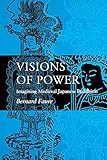Visions of Power : Imagining Medieval Japanese Buddhism / Bernard Faure.
Material type: TextPublisher: Princeton, NJ : Princeton University Press, [2021]Copyright date: ©1996Description: 1 online resource (352 p.) : 5 line drawingsContent type:
TextPublisher: Princeton, NJ : Princeton University Press, [2021]Copyright date: ©1996Description: 1 online resource (352 p.) : 5 line drawingsContent type: - 9780691219561
- Buddhist art and symbolism -- Japan
- RELIGION / Buddhism / General (see also PHILOSOPHY / Buddhist)
- Aśvaghoṣa
- Barthes, Roland
- Bassui Tokusho
- Certeau, Michel de
- Chogen
- Daigenshuri
- Daijōji
- Eikan
- Ennin
- Foucault, Michel
- Four Gates
- Gien
- Hakusan
- Han Yu
- Hirata Atsutane
- Jidian
- Kakunyo
- Mannoni, Octave
- Mauss, Marcel
- Nabokov, Vladimir
- Pei Xiu
- Puji
- Ratnakuta-sûtra
- Rujing
- Samantabhadra
- Shenhui
- Shinran
- Shungi
- Shunjō
- Tambiah, Stanley
- Uttarakuru
- Vajraputra (Arhat)
- Weber, Max
- Wittgenstein, Ludwig
- Xiangguosi
- Yijingy
- Zhiyi
- dhdrani
- iconoclasm
- imaginaire
- kechimyaku
- lay adepts
- manjala
- okibumi
- sacred springs
- symbols
- Ānanda
- 294.3927 22
- online - DeGruyter
| Item type | Current library | Call number | URL | Status | Notes | Barcode | |
|---|---|---|---|---|---|---|---|
 eBook
eBook
|
Biblioteca "Angelicum" Pont. Univ. S.Tommaso d'Aquino Nuvola online | online - DeGruyter (Browse shelf(Opens below)) | Online access | Not for loan (Accesso limitato) | Accesso per gli utenti autorizzati / Access for authorized users | (dgr)9780691219561 |
Frontmatter -- CONTENTS -- LIST OF ILLUSTRATIONS -- ACKNOWLEDGMENTS -- LIST OF ABBREVIATIONS -- INTRODUCTION -- CHAPTER ONE Autobiographical Imagination -- CHAPTER TWO Imagined Lineages -- CHAPTER THREE Imagining Powers -- CHAPTER FOUR Mythical Imaginaire -- CHAPTER FIVE Dreaming -- CHAPTER SIX Images of Death -- CHAPTER SEVEN Places of the Mind -- CHAPTER EIGHT The Ritual Body -- CHAPTER NINE The Power of Symbols -- CHAPTER TEN Iconic Imagination -- CHAPTER ELEVEN Beyond Icons -- EPILOGUE Imagination and Ideology -- GLOSSARY -- BIBLIOGRAPHY -- INDEX
restricted access online access with authorization star
http://purl.org/coar/access_right/c_16ec
Bernard Faure's previous works are well known as guides to some of the more elusive aspects of the Chinese tradition of Chan Buddhism and its outgrowth, Japanese Zen. Continuing his efforts to look at Chan/Zen with a full array of postmodernist critical techniques, Faure now probes the imaginaire, or mental universe, of the Buddhist Soto Zen master Keizan Jokin (1268-1325). Although Faure's new book may be read at one level as an intellectual biography, Keizan is portrayed here less as an original thinker than as a representative of his culture and an example of the paradoxes of the Soto school. The Chan/Zen doctrine that he avowed was allegedly reasonable and demythologizing, but he lived in a psychological world that was just as imbued with the marvelous as was that of his contemporary Dante Alighieri. Drawing on his own dreams to demonstrate that he possessed the magical authority that he felt to reside also in icons and relics, Keizan strove to use these "visions of power" to buttress his influence as a patriarch. To reveal the historical, institutional, ritual, and visionary elements in Keizan's life and thought and to compare these to Soto doctrine, Faure draws on largely neglected texts, particularly the Record of Tokoku (a chronicle that begins with Keizan's account of the origins of the first of the monasteries that he established) and the kirigami, or secret initiation documents.
Mode of access: Internet via World Wide Web.
In English.
Description based on online resource; title from PDF title page (publisher's Web site, viewed 30. Aug 2021)


